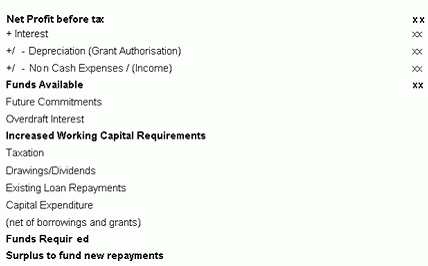Repayment Capacity and Projections
Category: Financial Risk Management
The banker’s primary interest in analysing financial statements is to establish the level of risk attaching to existing or proposed borrowings, but more particularly, to estimate if repayment capacity exists at present and is likely to exist throughout the period of the borrowings. To do this, we clearly cannot rely solely on historical figures but must make some effort to forecast what some key figures will look like in the future.
Basically, there are two methods used by bankers:
Estimate Repayment Capacity on the basis of the historical figures and certain assumptions about the future.
Obtain Cash Flow Forecasts from the customer and analyse them to ensure they are reasonable and prudent.
Estimating Repayment Capacity
Bank borrowings are ultimately repaid from the surplus of cash inflows over outflows. We can estimate this starting with our Net Profit figure as next.
The difficulty with this calculation is that we must make certain assumptions to make it meaningful. For example;
We may assume that the business is operating in an extremely stable environment and that the profit figure and the various adjustments will be the same in future years as in the past year, or
We may assume that profit will continue to increase at the same rate as over the past 5 years and make our calculation accordingly, or
We may make alternative assumptions concerning key variables such as Capital expenditure, interest rates etc.
Clearly, because we are dealing with the future, all of the assumptions we may make are open to question.
Cash Flow Forecasts
It makes sense for the banker to request the customer to provide projections showing how the customer estimates future finances will look. In particular, lending bankers usually request cash flow forecasts for the period of the borrowing.
Once again, it is the assumptions underlying these forecasts which must be examined carefully. Next shows some of the key components that must be scrutinised.
Future cash flow assumptions:
— Sales Forecast
— Expenses Forecast
— Debtors Collection Period
— Stock Holding Period
— Credit Payments Period
The Sales Forecast can be particularly difficult to analyse because it can be affected by so many factors.
For example, (These could perhaps be written on a flipchart)
Total Market Size
Market Trends
Competition
Economic Conditions and Outlook
Anticipated Market Share
Potential Production Capacity
Forecast expenses will often follow historical trends, however this cannot be taken for granted. For instance, changes in production volume or product mix may lead to irregular variations. Also, suppliers may impose increased input costs.
Unless we have reasons to believe otherwise, it is often safest to assume that Debtor Collection Period, Stock Holding Period, and Creditor Payment Period will not vary from year to year. However, we must still question the customer to establish that this is a likely scenario. When in doubt, bias should be towards prudence.

